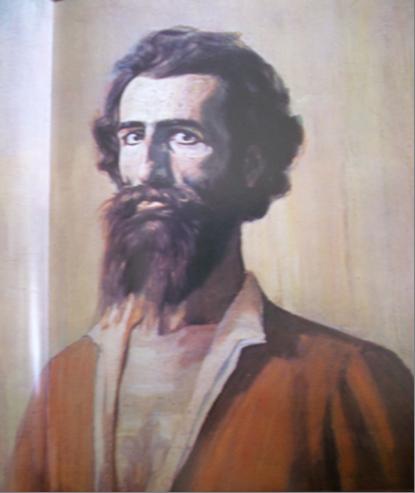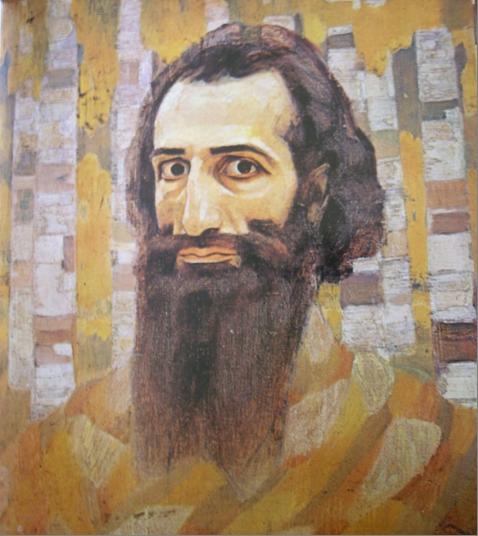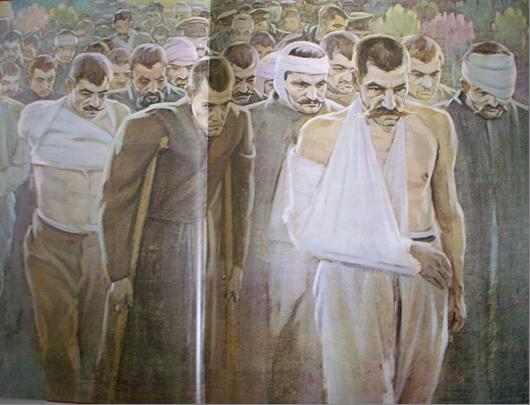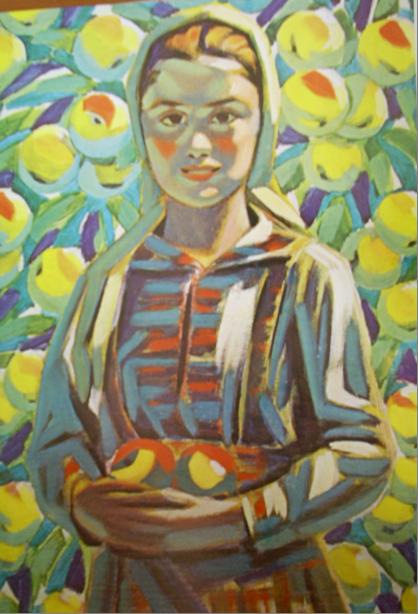
Reserved Area
Artists - ArtWorks
Vladimir Dimitrov
 Bulgaria
BulgariaRealism
Vladimir Dimitrov – the Master – series of portraits and paintings from the village of Shishkovtsi
National art – realism. The artist is active during the beginning of the ХХ century until the end of the 40s.
The Master, noble in character and influenced by Tolstoyism, was very far removed from the whole atmosphere of wild bacchanalia and artificially inflamed jingoist exaltation to which not a small part of the Bulgarian intellectuals had become prey. A real humanist, he did not fail to see and portray the tragedy, but he recorded it not in the scenes in which bitterness and hatred had poisoned the mind, but in those hours of endless, exhausting marches or brief pauses, when man turned to his inner self, to his past, to his land.
After the wars, great changes became apparent in the Master's aesthetics and stile. They were linked with the movement for a return to native art, evident in all fields of creative endeavour in Bulgaria. It was not a question of a return to the old traditions from an external point of view by solving a thematic problem centred around the simple representations of Bulgarian peasants and portrayal of ethnographic details; such methods had been adopted by Bulgarian artists soon after the country's national liberation.
1903 – 1910 - enrolled at the School of Painting, Sofia (in the painting section). Lecturers: Zheko Spiridonov (modelling), Anton Mitov (History of Art), Petko Klissourov (drawing), Mrkvicka (painting). His teachers are the creators of professional art education in Bulgaria and the first post-liberation artists – followers of the academism. Characteristic for the period is the upheaval in fine arts in Bulgaria, which now are professionally based. The ruling style is that of realism.
After 1918 the strongest art movements becomes the newly formed “National art”. This time it was rather a question of the recreation of the actual Bulgarian spirit and form. It meant a search for something specifically Bulgarian in the types and scenes, a discovery of lasting values in the Bulgarian psychology as it had been manifest for centuries on end. It also meant a return to styles, types, plastic metaphors, expressive deformations or, to put in a nutshell, a rejection of naturalism and a sui genesis approach to the language of modern art.
The Master was the most outstanding figure in this process of return to native values. Early in the twenties he produced a series of pictures which revealed the elements of a new plastic syntax capable of expressing the national spirit in art.
Very interesting is the connection between the Master and another great painter of that time – Boris Georgiev. Andrey Protich /art analyst/ says: "That, which brought them close at their first meeting, could only be their apostle-kind devotion to art”. The Master is very interested by the ideas of Tolstoyism, while Boris Georgiev is a follower of Nicholas Roerich and Rabindranath Tagore, which points to their shared pantheistic view of the world. When their paintings are compared, what strikes is their common humanism and the different approach in achieving this. The Master does it through folklore and color, Boris Vasilev through wonderful realistic paintings and mystic plots. Regardless of this difference between them – one of them being strongly connected to his Bulgarian roots, while the other being a cosmopolitan – they are both quite famous not just in Europe, but also in America.
The Master’s portraits are mainly characterized like this:
His colour scheme assumed a heightened decorative value, he employed spectrally pure hues, making full use of complementary contrast by destroying the local colouring of the object.
The general chromatic scale and texture, by means of which the figures he represented in the foreground and in the background - their milieu and their spiritual affinity and participation, determined a sui generis pantheism. The likeness of a girl or a peasant woman set against a fragment of natural surroundings (in which flowers or fruits seem to symbolize the abundance of the Bulgarian land) assumes a deeper meaning than a plein air portrait. These portraits suggest the universal link between man and nature, a unity in which the spiritual is reflected in the material and vice versa. Man and nature appear as modifications of one and the same cosmic substance possessing a single soul and pulsating with the same rhythm as part of the eternal world rotation.
Another and no less important stylistic and plastic change could be observed in the decorative rendering of the background, when a second plane is added to the composition and second plane shows no spatial depth. This signified a break with the academic tradition of the Renaissance linear and aerial perspective, bringing the Master's work closer to the plastic experiments of modern European artists and making it akin to the aesthetics of the Bulgarian popular icon painters of the past.
Thus the Master found the right path of a return to the native: a path of creating an art which is modern in form and is related inspirit to the old traditions of Bulgarian decorative art. The iconographic basis of this stylistic change made the artist set up several fundamental requirements before his art.
Thus, the Master’s paintings can be declared iconic /in the sense of static and frontal positioning of figures/ and colorfully expressionistic.
In its core the Master’s art is unique. Transnational influences cannot be sought even only to due to the fact that he rejects academism. At the same time he is well acquainted with the art of Europe, because he does a lot of traveling during his artistic career. By knowing the traditions, he creates a Bulgarian product of European value.
In the beginning of his artistic path, he predominantly paints portraits of intellectuals and of his relatives and friends (of Buchvarov, Alexander Teodorov-Balan, Nikolay Liliev, Ivan Mrkvicka, "My mother») and landscapes ("At the old fountain”, "Midday resting herd" and others) in an academic style close to those of his teachers.
During the Balkan War and the I World War he is an artist in the Rila division of the Bulgarian army. In many paintings he depicts the Bulgarian participation in these wars and the life at the front - "Wounded", "Close to Belasitsa", "Handicapped", "At the front of Struma river", "In Skopje 1916", "Coming back from the front" and others. As a result of these events his life takes a new turn and he focuses on humanism and beauty, to the perfection and harmony in the life of the ordinary person.
After the wars he strengthened his position as an artist rejecting academism in fine arts. During 1922 he presents the paintings from his cycle "Harvest", with which he sets the beginning of his own style, differentiating him form all other painters. During 1923 he works in Italy, while from 1924 till 1951 he lives in the village of Shishkovtsi, close to the city of Kyustendil, and conducts exhibitions both in Sofia and other cities as well as in the nearby villages – Shishkovtsi, Divlya, Rujdavitsa and others. During this period the topics of his works are mainly connected with the people and nature in the area of Kyustendil: "Lasses" (around 1925-1935), "Sisters from the village of Divlya, close to Radomir" (around 1928-1930), "Palm sunday", (ок. 1928), "A girl from Kyustendil" (around 1930-1935), "Harvester" (1930-1935), "A girl with apples" (around 1930-1935), "A harvester from Shishkovtsi" (1935), "Harvesters at noon" (around 1935-1938), "Diggers" (around 1935-1938), "A village girl among the poppies" (1935-1938) and others. He never changes his style and vision of life and art or switches the topic of his work until the end of his life.
As a resistance to the academism in art, the manifest of national art turns the artistic quests to folklore, traditions and the rural life; this artist is the most prominent representative of this trend; he becomes world-known while still living and has a unique distinctive style.
Encyclopedia of visual arts in Bulgaria, volume ІІ, М – R. Sofia, Bulgarian academy of sciences.
The Master’s Madonnas. Sofia: Polireks, 2003.
Konstantin Rangelov Elenkov, New book on the Master. Sofia: Zvezdan, 2003. 88 pages.
http://www.artgallery-themaster.com/bg/index.htm
http://www.artimpresia.com/index.php?option=com_seyret&Itemid=98&task=videodirectlink&id=12
http://repository.upenn.edu/cgi/viewcontent.cgi?article=1001&context=uhf_2006
http://www.pmg-kn.eu/maystora/main.php?lang=bg&page=home
Related Material:
Image available

File name: 21_XX 1.JPG
Description of the material:
An early self-portrait of the author, which demonstrates his academic background.
Contextualisation Of the source:
A dedicated web-site with information on the artist and his works: http://www.pmg-kn.eu/maystora/main.php?lang=bg&page=home Several different image sections – graphics, portraits, landscapes, self-portraits – depict rather strongly the mastership of the artist.
Interpretation of the source:
This is one of the early works of the artist, in which he still follows the academic doctrine in fine arts.

File name: 21_XX 2.JPG
Description of the material:
A self-portrait of the artist.
Contextualisation Of the source:
A dedicated web-site with information on the artist and his works: http://www.pmg-kn.eu/maystora/main.php?lang=bg&page=home Several different image sections – graphics, portraits, landscapes, self-portraits – depict rather strongly the mastership of the artist.
Interpretation of the source:
This portrait demonstrates the artist’s transition to a style of his own, rejecting the dogmas of the academic art.

File name: 21_XX 3.JPG
Description of the material:
The early painting “Handicapped”.
Contextualisation Of the source:
A dedicated web-site with information on the artist and his works: http://www.pmg-kn.eu/maystora/main.php?lang=bg&page=home Several different image sections – graphics, portraits, landscapes, self-portraits – depict rather strongly the mastership of the artist.
Interpretation of the source:
A work from the time he spent as a war-artist in the Rila division. This painting shows the impact, which war has on people and on artists. The focus is on the ordinary soldiers – struck by war.

File name: 21_XX 4.JPG
Description of the material:
The painting “A girl with apples”.
Contextualisation Of the source:
A dedicated web-site with information on the artist and his works: http://www.pmg-kn.eu/maystora/main.php?lang=bg&page=home Several different image sections – graphics, portraits, landscapes, self-portraits – depict rather strongly the mastership of the artist.
Interpretation of the source:
A remarkable piece of art, presenting the unique style of the artist with strong colors, bright lights and focus on the ordinary people.
Comments about this Artist/ArtWork
Date: 2009.09.18
Posted by Ewa Bajon, POLAND
Message: Wladimir Dimitrow – Maistora
Bulgarian painter, drawer , pedagogue . He is considered to be one of the most talented representatives among 20th century Bulgarian painters and probably the most remarkable stylist in Bulgarian painting in the post- Russian-Turkish War era. His portraits and compositions have expressive color, idealistic quality of the image and high symbolic strength. If you wish to come closer to the wonderful mastery of that artist I recommend you to choose the link below:
http://images.google.pl/images?hl=pl&rlz=1G1GGLQ_PLPL324&q=Vladimir+Dimitrov&lr=&um=1&ie=UTF-8&ei=aF6vSp2RC4ab_AbO-L3XDg&sa=X&oi=image_result_group&ct=title&resnum=4
Michelangelo - Copyright 2008 - This project has been funded with support from the European Commission